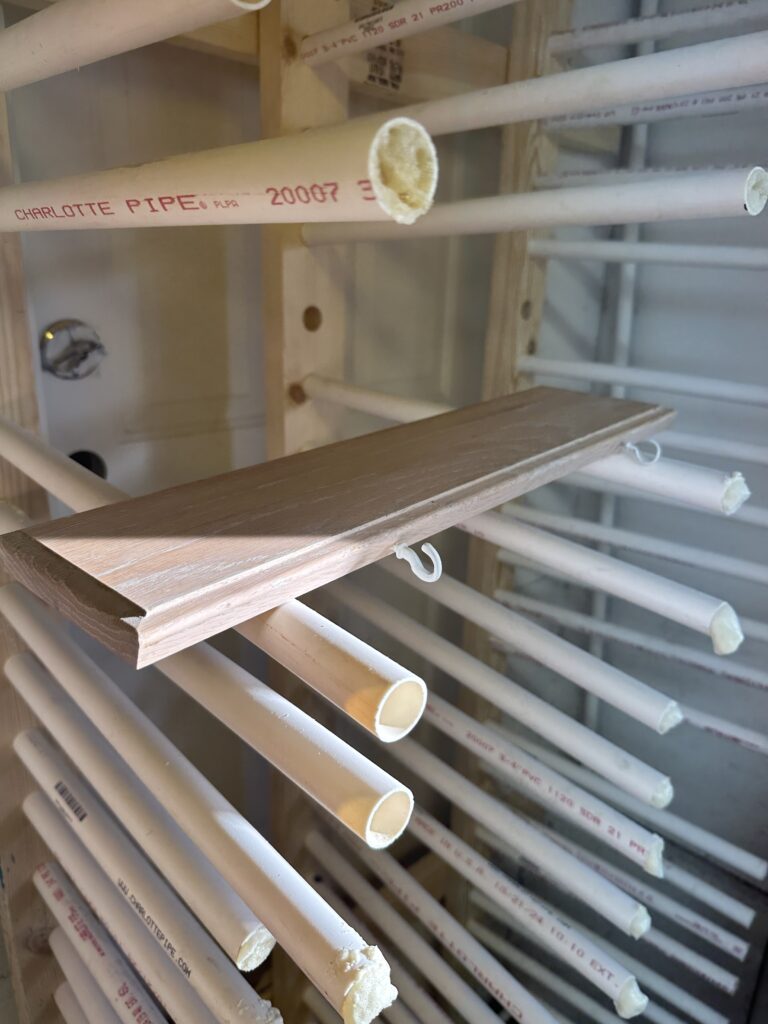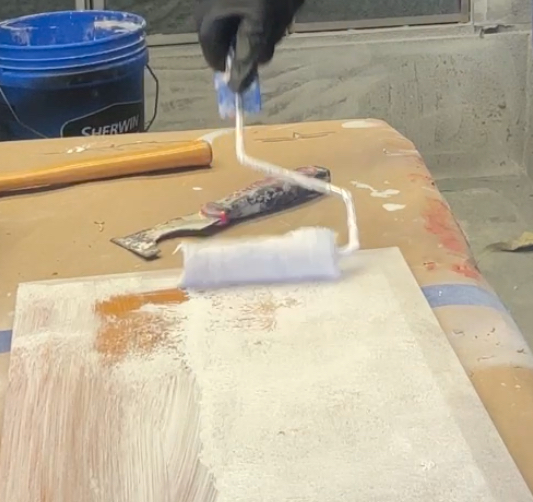Cabinet Painting- Rolling vs. Spraying
A fresh coat of paint can revamp your kitchen or bathroom cabinets, giving them a whole new life—sometimes even making the entire room feel brand new. But before you get to the fun part of choosing paint colors, you’ll need to decide how to apply your primer. The big debate in Cabinet Painting- Rolling vs. Spraying
While we help homw owners in our surrounding communities like Gilberts, Elgin, Crystal Lake, Woodstock, and South Elgin, this topic related to almot every homeowner. Which application method will give the best results with the least hassle? Both rolling and spraying have their pros, cons, and practical considerations.
Let’s break down each method, offer a quick how-to guide, and answer common questions to help you make the right choice for your cabinets.
Understanding the Basics of Cabinet Primer
Regardless of how you apply it, primer is the essential first step in a lasting paint job.
It is why paint adheres to your cabinet doors.
The right primer also blocks stains, and creates a smooth, uniform surface. (Read more here) When deciding between rolling and spraying primer, it often comes down to:
- Time
- Finish Quality
- Level of Expertise or Comfort
- Space you have to paint
- the cost to DIY or hire it out to a professional cabinet painter
Rolling Primer on Cabinet Doors
Pros of Rolling Primer
- Easier for Beginners
Rolling primer is often more approachable if you’re new to DIY projects. You can see exactly where the primer is going and control the application more simply. - Less Setup, Less Cleanup
A paint tray and a quality roller cover are typically all you need to get started. Cleanup is also simpler—there’s no disassembling or cleaning a spray gun. - NO Overspray
When you’re rolling, you’re not dealing with tiny airborne particles of primer. This reduces the risk of primer landing on surrounding surfaces, which can be critical if you’re painting in a small kitchen or near finished floors. - Minimal Equipment Costs
A roller frame, roller covers, and a paint tray are relatively inexpensive compared to investing in a quality sprayer. - Filling oak grain
- we roll primer on oak cabinet doors to fill in the open wood gran pores to get a solid finish

Cons of Rolling Primer
- Possible Texture
Rollers can create a subtle texture (often called “orange peel”), which might not be an issue on walls but can be noticeable on smooth cabinet doors. Using a high-density foam roller can help minimize this, but it won’t match the ultra-smooth finish of a professional spray job. - Slower Process
Rolling each cabinet door (front and back) can take a bit more time, especially if you’re trying to apply even pressure and maintain a consistent coat. - More Physically Demanding
Holding a roller and tray, bending over doors, and carefully covering edges can be tiring. If you have a lot of cabinets, this might add up. - You need toom!
- you need a lot of space to roll out every door and drawer
Spraying Primer on Cabinet Doors
Pros of Spraying Primer
- Smooth, Professional Finish
Spraying generally delivers a flawless finish with no roller lines or brush marks. Many pros in Elgin and Crystal Lake prefer spraying specifically for cabinets because of the sleek, uniform look. - Faster Application
Once you get the hang of it, a spray gun can apply primer more quickly than rolling—especially if you have many cabinet doors to cover. - Easy to Reach Crevices
Cabinets often have grooves, raised panels, and decorative trim. A sprayer can get into these detailed areas more easily, with out or drips and providing even coverage without repeated passes.
Cons of Spraying Primer
- Equipment and Setup
You’ll need a sprayer (either an HVLP or airless system), which can be a bigger upfront investment. There’s also a learning curve to using sprayers effectively. - Potential for Overspray
Tiny primer particles can end up on nearby surfaces, so you’ll need to mask off the space carefully. Overspray can be particularly challenging in tight kitchens or if you’re painting cabinet doors inside your home. - Ventilation and Safety
Spraying primer (especially indoors) requires proper ventilation and personal protective equipment (PPE). Unless you are hanging doors on a hang rack- You’ll also need space to lay out cabinet doors, ideally in a well-ventilated garage or workshop.
Which Method Is Right for You?
- Rolling is ideal if: You have limited space, a tight budget for equipment, are concerned about overspray, or prefer a simpler, more controlled approach.
- Spraying is ideal if: You already own or are willing to invest in a sprayer, want a nearly “factory-like” smooth finish, and have space to safely set up and spray your cabinet doors.
Ultimately, the right choice depends on your level of comfort, the tools you have access to, and the finish you desire.
If you live in Gilberts or South Elgin and plan to tackle a large set of cabinets, spraying might be worth the initial effort—especially if you value that professional look.
On the other hand, homeowners with smaller kitchens and fewer doors and drawers, who have fewer cabinets, and are on a budget- may prefer a simpler setup might stick to rolling.
How to Roll Primer on Cabinet Doors (Step-by-Step)
- Remove Doors and Hardware
- Take off each cabinet door, hinges, and handles. Label or bag these parts to keep track of where they belong.
- Clean and Degrease
- Kitchens and bathrooms can be greasy. Wipe down surfaces with a degreaser or mild detergent. Let everything dry thoroughly.
- Lightly Sand
- Use 220-320-grit sandpaper to scuff up the surface so the primer can adhere better. We like wet sanding -read more here..Wipe away dust with a tack cloth.
- Set Up Your Rolling Station
- Use sawhorses or a flat work surface protected by drop cloths or plastic. Place your paint tray nearby, filled with primer.
- Roll On the Primer
- Dip a high-density foam or short-nap roller into the primer. Roll in smooth, consistent strokes, slightly overlapping each pass.
- Be mindful of edges and corners—use a small foam brush if needed.

- Allow to Dry
- Follow the primer’s recommended dry time. Plan to flip the door over only after it’s thoroughly dry to avoid smudging.
- Lightly Sand Again (Optional)
- If you see any texture or imperfections, a quick light sanding helps smooth them out before adding your topcoat of paint.
How to Spray Primer on Cabinet Doors (Step-by-Step)
- Prep Your Doors
- Just like with rolling, remove the doors, clean them, and sand lightly. Label each one to remember where it goes.
- Protect Surrounding Areas
- If you’re spraying indoors, mask off walls, floors, and countertops. Ideally, spray in a garage or workshop with doors or windows open for ventilation.
- Set Up Your Sprayer
- Ensure you have the correct tip or nozzle for primer. HVLP (High Volume, Low Pressure) sprayers are popular for a fine finish. Test on cardboard or scrap wood to dial in your settings.
- Spray in Smooth, Even Passes
- Keep the sprayer nozzle about 6–8 inches from the surface. Move in steady, overlapping strokes.
- Avoid lingering too long in one spot to prevent drips.
- Dry and Flip
- Lay cabinet doors flat on sawhorses or a drying rack. Allow them to fully dry per the manufacturer’s instructions before flipping or applying a second coat.
- Sand Between Coats
- If recommended, do a light sanding to ensure the next coat adheres and evens out any minor imperfections.
Frequently Asked Questions on rolling cabinet paint
Below are some top questions homeowners often search for when deciding between rolling primer and spraying primer on cabinet doors.
1. Which method gives a smoother finish?
Spraying typically produces the smoothest finish because there’s no direct contact from a roller or brush that can leave texture.
High-density foam roller can get pretty close to that smooth look, especially on flatter cabinet designs.
2. Does spraying primer waste more product?
Spraying can result in some wasted product due to overspray. HVLP sprayers can significantly reduce waste compared to an airless sprayer.
If you’re mindful of technique and properly mask off the area, product waste can be minimal.
3. Is one method faster than the other?
Spraying can be faster in terms of getting the primer on each door. But remember to factor in setup and cleanup time.
Rolling has less setup, yet it can be more time-consuming to apply—especially if you have many doors.
4. Do I need special ventilation for rolling?
You still need good ventilation anytime you’re using primer or paint. However, rolling produces fewer airborne particles compared to spraying, so you won’t need as extensive a setup (e.g., exhaust fans).
5. Can I achieve a professional look by rolling the primer?
Absolutely. While spraying might be the easiest route to a flawless finish, rolling with the right roller cover, technique, and patience can yield impressive results—especially if you plan to lightly sand between coats.
6. What if I only have outdoor space to spray?
Spraying outdoors is possible, but be mindful of wind, dust, and insects that can land on wet primer.
A garage or enclosed in the areas Woodstock or Gilberts home (with ample ventilation) is often safer for controlling the environment.
Final Thoughts
When it comes to primer application, there’s no definitive “one-size-fits-all” answer. Whether you choose to roll or spray depends on your comfort level, tools, budget, and the time you can invest. Rolling is straightforward and more accessible for beginners, with less chance of overspray and minimal equipment costs. Spraying, on the other hand, can yield a smoother, more professional finish in less time—if you’re willing to learn and manage the extra prep and cleanup.
For homeowners in Gilberts, Elgin, Crystal Lake, Woodstock, and South Elgin, either approach can be done successfully, as long as you prepare your cabinet doors properly and follow best practices. If you’re still unsure which method to go with—or if you’re simply short on time—consider reaching out to a local painting professional. They can assess your cabinets, provide advice on rolling vs. spraying, and help you achieve the look you’ve always wanted.
In the end, the goal is to prime your cabinets effectively so your final paint job looks beautiful and lasts for years. With the right method and a little know-how, you’ll be enjoying your “new” cabinets before you know it!


